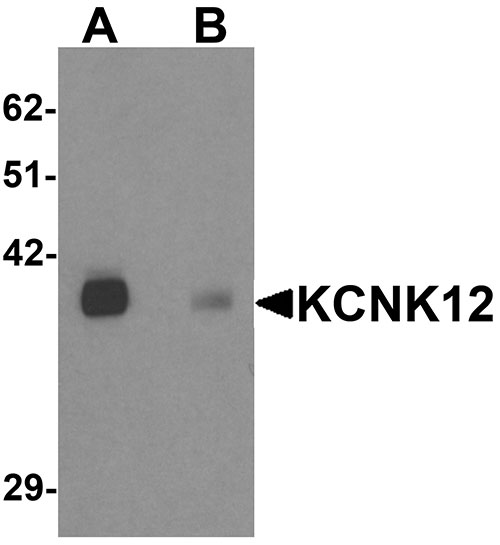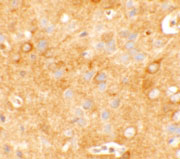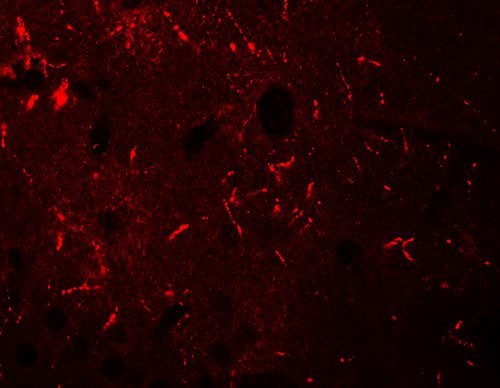KCNK12 Antibody
- 产品详情
- 实验流程
- 背景知识
Application
| WB, IF, E, IHC-P |
|---|---|
| Primary Accession | Q9HB15 |
| Other Accession | NP_071338, 11545761 |
| Reactivity | Human, Mouse, Rat |
| Host | Rabbit |
| Clonality | Polyclonal |
| Isotype | IgG |
| Calculated MW | 46889 Da |
| Concentration (mg/ml) | 1 mg/mL |
| Conjugate | Unconjugated |
| Application Notes | KCNK12 antibody can be used for detection of KCNK12 by Western blot at 0.5 µg/mL. Antibody can also be used for immunohistochemistry starting at 5 µg/mL. For immunofluorescence start at 20 µg/mL. |
| Gene ID | 56660 |
|---|---|
| Other Names | Potassium channel subfamily K member 12, Tandem pore domain halothane-inhibited potassium channel 2, THIK-2, KCNK12 |
| Target/Specificity | KCNK12; KCNK12 antibody is predicted to not cross-react with other KCNK protein family members. |
| Reconstitution & Storage | KCNK12 antibody can be stored at 4℃ for three months and -20℃, stable for up to one year. As with all antibodies care should be taken to avoid repeated freeze thaw cycles. Antibodies should not be exposed to prolonged high temperatures. |
| Precautions | KCNK12 Antibody is for research use only and not for use in diagnostic or therapeutic procedures. |
| Name | KCNK12 {ECO:0000303|PubMed:24163367, ECO:0000312|HGNC:HGNC:6274} |
|---|---|
| Function | K(+) channel subunit that may homo- and heterodimerize to form functional channels with distinct regulatory and gating properties. Can heterodimerize with KCNK13 subunit to conduct K(+) outward rectifying currents at the plasma membrane. The homodimers are mainly retained in the endoplasmic reticulum compartment and may be targeted to the cell surface upon phosphorylation or other activation signals yet to be elucidated. |
| Cellular Location | Cell membrane; Multi-pass membrane protein. Endoplasmic reticulum membrane; Multi-pass membrane protein |
For Research Use Only. Not For Use In Diagnostic Procedures.
Provided below are standard protocols that you may find useful for product applications.
BACKGROUND
KCNK12 Antibody: KCNK13 and KCNK12 (also known as THIK1 and 2) are the first two members of a novel two pore-forming P domains K+ channels subfamily. The pore loop domain, a highly conserved region common to all potassium channels, is involved in determining potassium ion selectivity. Members of this family are all characterized by four transmembrane domains and may function to help influence the resting membrane potential of cells. KCNK12 is expressed mainly in the brain and lung, but also observed in the kidneys, heart and skeletal muscle. KCNK12 is closely related to KCNK13 (58% identity at the amino acid level), but could not yet been functionally expressed in vitro and may require other proteins to become active.
REFERENCES
Rajan S, Wischmeyer E, Karschin C, et al. THIK-1 and THIK-2, a novel subfamily of tandem pore domain K+ channels. J. Biol. Chem. 2001; 276:7302-11
Jezzini SH and Moroz LL. Identification and distribution of a twopore domain potassium channel in the CNS of Aplysia californica. Brain Res. Mol. Brain Res. 2004; 127:27-38
Theilig F, Goranova I, Hirsch JR, et al. Cellular localization of THIK-1 (K(2P)13.1) and THIK-2 (K(2P)12.1) K channels in the mammalian kidney. Cell Physiol. Biochem. 2008; 21:63-74.
Girard C, Duprat F, Terrenoire C, et al. Genomic and functional characteristics of novel human pancreatic 2P domain K+ channels. Biochem. Biophys. Res. Commun. 2001; 282:249-56.
终于等到您。ABCEPTA(百远生物)抗体产品。
点击下方“我要评价 ”按钮提交您的反馈信息,您的反馈和评价是我们最宝贵的财富之一,
我们将在1-3个工作日内处理您的反馈信息。
如有疑问,联系:0512-88856768 tech-china@abcepta.com.























 癌症的基本特征包括细胞增殖、血管生成、迁移、凋亡逃避机制和细胞永生等。找到癌症发生过程中这些通路的关键标记物和对应的抗体用于检测至关重要。
癌症的基本特征包括细胞增殖、血管生成、迁移、凋亡逃避机制和细胞永生等。找到癌症发生过程中这些通路的关键标记物和对应的抗体用于检测至关重要。 为您推荐一个泛素化位点预测神器——泛素化分析工具,可以为您的蛋白的泛素化位点作出预测和评分。
为您推荐一个泛素化位点预测神器——泛素化分析工具,可以为您的蛋白的泛素化位点作出预测和评分。 细胞自噬受体图形绘图工具为你的蛋白的细胞受体结合位点作出预测和评分,识别结合到自噬通路中的蛋白是非常重要的,便于让我们理解自噬在正常生理、病理过程中的作用,如发育、细胞分化、神经退化性疾病、压力条件下、感染和癌症。
细胞自噬受体图形绘图工具为你的蛋白的细胞受体结合位点作出预测和评分,识别结合到自噬通路中的蛋白是非常重要的,便于让我们理解自噬在正常生理、病理过程中的作用,如发育、细胞分化、神经退化性疾病、压力条件下、感染和癌症。








